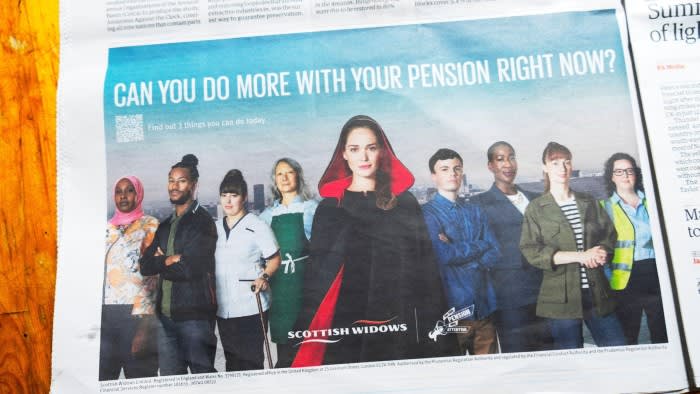Stay informed with free updates
Simply sign up to the Pensions industry myFT Digest — delivered directly to your inbox.
Scottish Widows is killing off the iconic “widow” model featured in its branding for decades, as the £200bn life insurer and pensions provider attempts to modernise the business.
Owned by Lloyds Banking Group, Scottish Widows said it was “phasing out” the widow model and will instead use a digital logo of a woman wearing a cloak.
The end of the human widow, used in the company’s advertising since the 1980s, is the latest example of a corporate rebranding reflecting a shift to digitally focused services. Deborah Moore, daughter of the late actor Sir Roger Moore, was the first widow.
“Customers will be so accustomed to that brand — will they recognise the new one?” asked Andrew Hagger, founder of consumer finance site MoneyComms.
“Is there a danger that people think of this as a new brand and forget the heritage of the old one?”
Hagger added that the use of a red silhouette instead of a human model “risks dehumanising” the brand, which has existed since 1815. The move was first reported by Citywire.
Chira Barua, chief executive of Scottish Widows, said: “One in four people in their twenties don’t have a pension and 38 per cent of adults are not on track for a minimum lifestyle in retirement, so we need to revolutionise the way people interact with longer-term savings to close that gap.
“Since we started building the app and digital tools, we’ve had phenomenal uplift in engagement and see this as a game-changer in helping people take the right steps now to get the retirement they want.”
Barua said the new Scottish Widows brand is aimed at feeling “more intuitive in digital channels like our app, but with a new look and ‘digital widow motif’ to bring it into a new era.”
James Daley, founder of consumer group Fairer Finance, said: “The Scottish Widows brand has been around a long time and is based on the human story. There’s been a different widow for decades — it’s the end of an era. The human element is relatable to a lot of people.
“The question is, will the new brand resonate with customers? Once you remove the human element, the brand becomes a bit irrelevant.”
Other companies that changed their brand include asset manager Abrdn. The fund group rebranded from Standard Life Aberdeen in 2021 by removing the vowels from Aberdeen. The company said at the time that the new name was “part of a modern, agile, digitally-enabled brand”.
However, the initiative was widely mocked. “It looked bonkers — why would you take the vowels out?” said Daley. “On the flip side, it got people talking about them.”
Royal Mail came under scrutiny when it changed its name in 2001 to Consignia, which was ditched just 16 months later. The UK postal service eventually rebranded its holding company to International Distributions Services.
Last year, National Express decided to change its name to Mobico as the UK transport group synonymous with long-distance coach journeys sought to project a more global image.
“Norwich Union was also a fantastic brand with a lot of heritage when they came up with Aviva,” said Daley. “It seemed mad at the time but now it’s just something you say.”
https://www.ft.com/content/67016d3a-06a3-4b4a-bb3e-608480eca833


